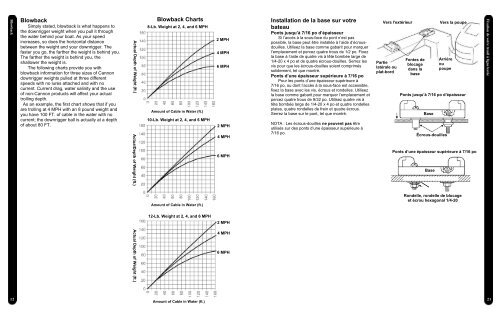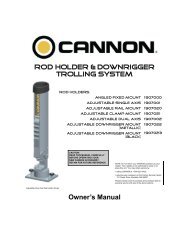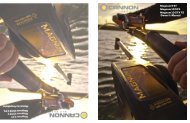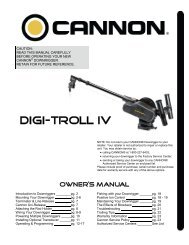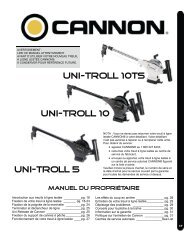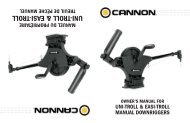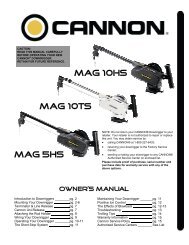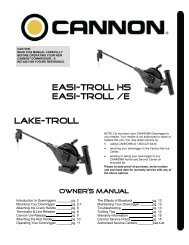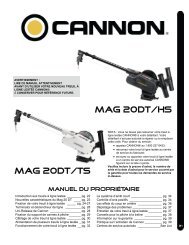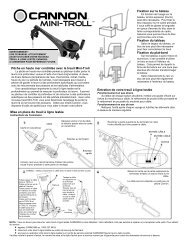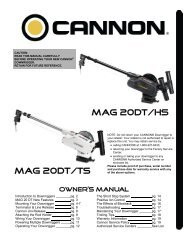3397104_Easi+Lake-Troll HS_Manual_rd.pub - Cannon Downriggers
3397104_Easi+Lake-Troll HS_Manual_rd.pub - Cannon Downriggers
3397104_Easi+Lake-Troll HS_Manual_rd.pub - Cannon Downriggers
Create successful ePaper yourself
Turn your PDF publications into a flip-book with our unique Google optimized e-Paper software.
Blowback<br />
Blowback<br />
Simply stated, blowback is what happens to<br />
the downrigger weight when you pull it through<br />
the water behind your boat. As your speed<br />
increases, so does the horizontal distance<br />
between the weight and your downrigger. The<br />
faster you go, the farther the weight is behind you.<br />
The farther the weight is behind you, the<br />
shallower the weight is.<br />
The following charts provide you with<br />
blowback information for three sizes of <strong>Cannon</strong><br />
downrigger weights pulled at three different<br />
speeds with no lures attached and with no<br />
current. Current drag, water salinity and the use<br />
of non-<strong>Cannon</strong> products will affect your actual<br />
trolling depth.<br />
As an example, the first chart shows that if you<br />
are trolling at 4 MPH with an 8 pound weight and<br />
you have 100 FT. of cable in the water with no<br />
current; the downrigger ball is actually at a depth<br />
of about 80 FT.<br />
Actual Depth of Weight (ft.)<br />
ActualDepth of Weight (ft.)<br />
Blowback Charts<br />
8-Lb. Weight at 2, 4, and 6 MPH<br />
Amount of Cable in Water (ft.)<br />
10-Lb. Weight at 2, 4, and 6 MPH<br />
2 MPH<br />
4 MPH<br />
6 MPH<br />
2 MPH<br />
4 MPH<br />
6 MPH<br />
Installation de la base sur votre<br />
bateau<br />
Ponts jusqu’à 7/16 po d’épaisseur<br />
Si l’accès à la sous-face du pont n’est pas<br />
possible, la base peut être installée à l’aide d’écrousdouilles.<br />
Utilisez la base comme gabarit pour marquer<br />
l’emplacement et percez quatre trous de 1/2 po. Fixez<br />
la base à l’aide de quatre vis à tête bombée large de<br />
1/4-20 x 4 po et de quatre écrous-douilles. Serrez les<br />
vis pour que les écrous-douilles soient comprimés<br />
solidement, tel que montré.<br />
Ponts d’une épaisseur supérieure à 7/16 po<br />
Pour les ponts d’une épaisseur supérieure à<br />
7/16 po, ou dont l’accès à la sous-face est accessible,<br />
fixez la base avec les vis, écrous et rondelles. Utilisez<br />
la base comme gabarit pour marquer l’emplacement et<br />
percez quatre trous de 9/32 po. Utilisez quatre vis à<br />
tête bombée large de 1/4-20 x 4 po et quatre rondelles<br />
plates, quatre rondelles de frein et quatre écrous.<br />
Serrez la base sur le pont, tel que montré.<br />
NOTA : Les écrous-douilles ne peuvent pas être<br />
utilisés sur des ponts d’une épaisseur supérieure à<br />
7/16 po.<br />
Vers l'extérieur<br />
Partie<br />
latérale ou<br />
plat-bo<strong>rd</strong><br />
Fentes de<br />
blocage<br />
dans la<br />
base<br />
Ponts jusqu’à 7/16 po d’épaisseur<br />
Base<br />
Écrous-douilles<br />
Base<br />
Vers la poupe<br />
Arrière<br />
ou<br />
poupe<br />
Ponts d’une épaisseur supérieure à 7/16 po<br />
Fixation de votre treuil à ligne lestée<br />
Amount of Cable in Water (ft.)<br />
Rondelle, rondelle de blocage<br />
et écrou hexagonal 1/4-20<br />
12-Lb. Weight at 2, 4, and 6 MPH<br />
2 MPH<br />
Actual Depth of Weight (ft.)<br />
4 MPH<br />
6 MPH<br />
12<br />
Amount of Cable in Water (ft.)<br />
21


